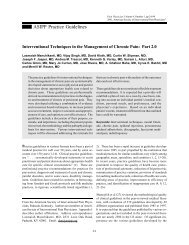Practice Management - Pain Physician
Practice Management - Pain Physician
Practice Management - Pain Physician
You also want an ePaper? Increase the reach of your titles
YUMPU automatically turns print PDFs into web optimized ePapers that Google loves.
Manchikanti • Documentation, Billing and coding 223<br />
records do document these things in various parts of the<br />
medical record. Documentation at this level is much more<br />
advantageous, for the physician, billing personnel, and<br />
investigators. This should include:<br />
• Symptoms of the patient with diagnosis<br />
itemized into:<br />
◆<br />
◆<br />
◆<br />
◆<br />
◆<br />
◆<br />
◆<br />
◆<br />
Each physical complaint with<br />
diagnosis;<br />
Medical problems with diagnosis;<br />
Psychological problems with diagnosis;<br />
The effect of pain on physical,<br />
functional, and psychological status,<br />
and activities of daily living, with its<br />
effect on quality of life;<br />
Effect of previous treatment(s), including<br />
all conservative modalities of<br />
treatments with drug therapy, physical<br />
therapy, chiropractic management,<br />
massage therapy, etc all interventional<br />
procedures, and surgical procedures;<br />
A statement to the effect that there is no<br />
significant evidence of intraspinal<br />
obstruction for any procedure on the<br />
spine;<br />
For repeat procedures, description of the<br />
quality and duration of relief with its<br />
resultant effect on functional status, as<br />
well as activities of daily living;<br />
Reasons for repeating the injection<br />
therapy; generally, the return of pain<br />
with some deterioration, with expectation<br />
of further deterioration in physical<br />
or functional status.<br />
Manchikanti and colleagues (8) defined indications and<br />
medical necessity for interventional pain procedures.<br />
Preoperative<br />
This should describe informed consent and preparation of<br />
the patient prior to the procedure including intravenous<br />
access, and sedation, etc.<br />
Intraoperative<br />
Documentation consists of:<br />
• Sedation and monitoring,<br />
• Appropriate positioning,<br />
• Sterile field preparation, and<br />
• Description of the procedure with needle<br />
placement, contrast injection findings, and<br />
injection of other drugs.<br />
Post-operative<br />
Documentation consists of:<br />
• Monitoring,<br />
• Complications,<br />
• Further treatment carried out in the<br />
postoperative phase.<br />
Discharge/Disposition<br />
Documentation consists of:<br />
• Status at discharge, and<br />
• Discharge instructions.<br />
Billing and Coding<br />
Billing and coding not only requires ICD-9-CM but also<br />
CPT-4, either 1999 or 2000 (4-8).<br />
<strong>Physician</strong>s’ current procedural terminology (CPT) is an<br />
up-to-date, comprehensive classification and nomenclature<br />
system for accurately identifying procedures and services<br />
by physicians and other health care professionals.<br />
At this point, interventional pain management is complicated<br />
by various issues as described in interventional pain<br />
management coding in the new millennium (7). The CPT<br />
2000 comprises numerous new codes of interest to interventional<br />
pain specialists, along with revisions of some<br />
old codes with result and deletion of multiple old codes<br />
(5-8). Thus, coding and billing described herewith will<br />
include both 1999 codes, as well as 2000 codes. Two documents<br />
entitled, “Interventional Techniques in the <strong>Management</strong><br />
of Chronic <strong>Pain</strong>:” Part 1.0 by Manchikanti et al (8)<br />
and “2000 Common Coding Scenarios for Spine Procedures<br />
and Injection Techniques” by the North American<br />
Spine Society (9) describe diagnostic and procedure coding<br />
in interventional pain management. This article manuscript<br />
will describe only commonly performed injection<br />
procedures and coding guidelines for the same.<br />
CORRECT CODING<br />
For purposes of correct coding, interventional pain physicians<br />
and their offices should be familiar with the medical/surgical<br />
practice and packages, modifiers, separate<br />
<strong>Pain</strong> <strong>Physician</strong> Vol. 3, No. 2, 2000
















